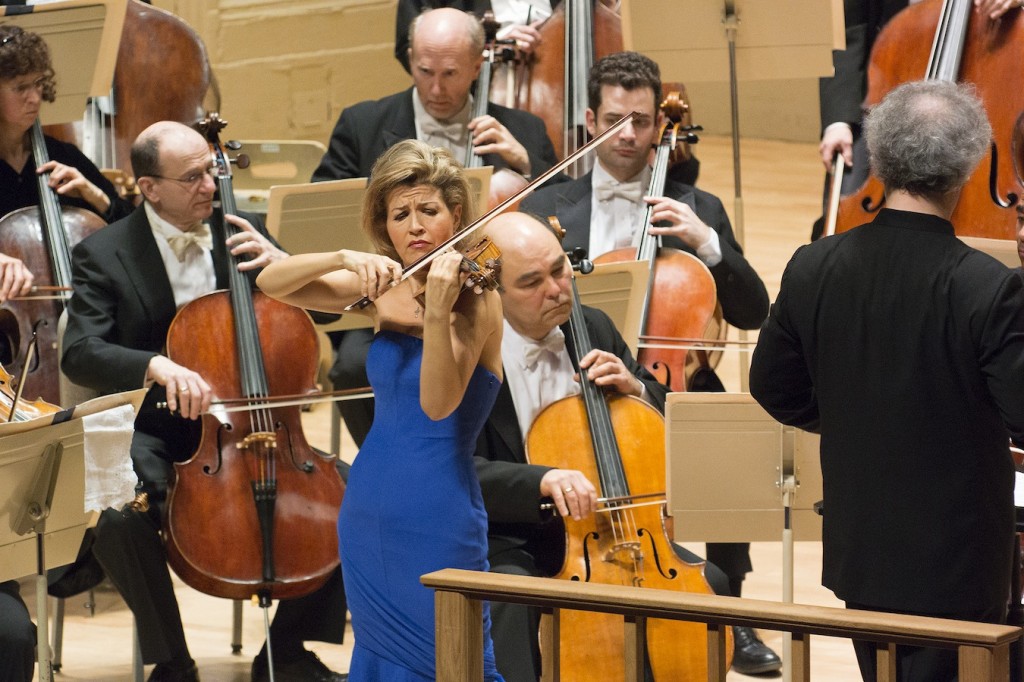Mutter brings out the lyrical charm of Dvořák with Honeck, BSO

Anne-Sophie Mutter performed music of Dvorak with Manfred Honeck and the Boston Symphony Orchestra Thursday night. Photo: Stu Rosner
Manfred Honeck made his long awaited return to Symphony Hall Thursday night when he conducted the Boston Symphony Orchestra in a spirited and insightful reading of Beethoven’s Symphony No. 3 in E-flat major, Eroica.
But the biggest draw of the evening was violinist Anne-Sophie Mutter, who performed double duty as soloist in two Dvořák delicacies: the Romance in F minor for violin and orchestra, Op. 11 and Violin Concerto in A minor, Op. 53.
As heard on her recent recording of these works (with Honeck conducting the Berlin Philharmonic) and performance Thursday night, Mutter’s playing is rife with free-flowing expression and razor-sharp focus. The rich copper hues of her violin tone gave the folk-like melodies of the Romance, based on the slow movement from the composer’s then unpublished String Quartet in F, a warm glow. To accompany her, Honeck pulled elegantly shaped phrases from the chamber-sized orchestra.
Dvořák’s Violin Concerto, written in 1879 but revised a few years later, is a work of similar intimacy and stirring beauty. That’s immediately evident in the arching cadenzas that open the first movement. The concerto may not have the show-stopping power of the Brahms and Tchaikovsky concertos, yet its technical filigree and rich lyricism make it a work of considerable difficulty. It is music that Mutter played with tenderness.
The most affecting moments came in the second movement, which features the same colorful wind writing the composer mined in his Serenade in D minor. Principal flutist Elizabeth Rowe wove delicate lines with the violinist’s earthy melodies into passages of sweet delight.
Mutter’s gentle portamenti and rubato phrasing were generally tasteful and inviting, but Honeck, directing with a steady, if stiff hand, did not always follow her lead. The biggest problem came in the finale, where Mutter’s exuberant strains in the mid-movement dumka pulled away from the orchestra’s more deliberate statements. A few strong gestures from Honeck brought the musicians up to speed.
The furiant that makes up the bulk of this movement, however, fared better and had the energy of a village band. Mutter’s dexterous handling of this fiery dance brought the concerto to a sparkling conclusion.
Following intermission, the BSO offered Beethoven’s Eroica Symphony. Groundbreaking for its expansive form and ear-bending sonorities, the Eroica stretched the possibilities of what the symphony as a genre could do. What began as an ode to Napoleon in 1804 was changed to celebrate an unnamed hero, perhaps Republican idealism itself. Its specific meaning remains elusive, but the Eroica was clearly designed to challenge contemporary listeners.
Honeck’s reading, notable for its buoyant tempos and elegant phrasing, was as much uplifting as it was searching. Sprightly music is built directly into the Scherzo, which the BSO played nimbly. The French horns performed the trio with aplomb.
Honeck’s quick tempo in the opening movement gave this music this familiar music a whirling feel of dance music. The biting syncopations also sounded with foot-stomping force. The variations and fugues of the finale, also taken at a brisk pace, had the delicate graces of the original contredanse on which this movement is based. For the augmented statements that conclude the work, the BSO gave grand treatment.
Honeck’s energetic tempos sometimes resulted in some untidy string playing, and the sweeping phrases in the outer movements did not always sound polished.
It was the second movement that featured the orchestra at its most colorful. Solo oboe gave the funeral march somber power, the strings offered a stirring fugato, and solo woodwinds brought a heavenly touch to the many trios that blossom from this music.
The program will repeat 1:30 p.m. Friday and 8 p.m. Saturday at Symphony Hall. bso.org;617-266-1492.
Posted in Performances



